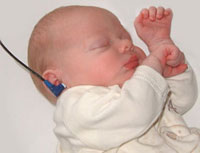Hearing test: Difference between revisions
| Line 18: | Line 18: | ||
==Otoacoustic Emission Testing== | ==Otoacoustic Emission Testing== | ||
( | (OAE) The basis of a simple infant hearing test of the inner ear. A small probe containing both a speaker producing "clicks" and a microphone to detect cochlea responses is placed inside the ear canal. Acoustic energy produced by vibration of the hair cells in response to the clicks is detected by the microphone within the probe. A more complex test that can be used at an earlier stage is the automated auditory brainstem response. | ||
==Neonatal Hearing Check List== | ==Neonatal Hearing Check List== | ||
Revision as of 08:07, 27 August 2011
Introduction
The incidence of significant permanent hearing loss is approximately 1-3/1000 newborns. Neonatal hearing screening is carried out in the USA, UK and in Australia (2002 NSW Statewide Infant Screening Hearing Program, SWISH) There is a general guide giving a timetable for a number of simple responses that a neonate should make if hearing has developed normally (More? Neonatal Hearing Check List).
State Wide Infant Screening Hearing Program (SWISH) a newborn hearing testing program using an automated auditory response technology (AABR). Program was introduced in NSW Australia in 2002 across 17 area health service coordinators. It is thought that in NSW 86,000 births/year = 86-172 babies potentially born with significant permanent hearing loss.
Automated Auditory Brainstem Response (AABR) uses a stimulus which is delivered through earphones and detected by scalp electrodes. The test takes between 8 to 20 minutes and has a sensitivity 96-99%.
Automated Auditory Brainstem Response
(AABR) uses a stimulus which is delivered through earphones and detected by scalp electrodes. The test takes between 8 to 20 minutes and has a sensitivity 96-99%. The basis of a neonatal hearing test that uses a trigger stimulus delivered through earphones and subsequent brain electrical activity then detected by scalp electrodes. Then by computer analysis, averaging all the electrical activity following the trigger, peaks emerge reflecting signal passage activity through brain stem nuclei in the hearing central neural pathway. The infant test takes between 8 to 20 minutes, has a sensitivity 96-99%, and unlike other childhood auditory testing does not require a subject response. An alternative and simple test (pass/refer) used at a later stage is otoacoustic emission testing.
Otoacoustic Emission Testing
(OAE) The basis of a simple infant hearing test of the inner ear. A small probe containing both a speaker producing "clicks" and a microphone to detect cochlea responses is placed inside the ear canal. Acoustic energy produced by vibration of the hair cells in response to the clicks is detected by the microphone within the probe. A more complex test that can be used at an earlier stage is the automated auditory brainstem response.
Neonatal Hearing Check List
The timing and types of responses listed below reflect only a rough guide for the general population. Abnormalities in neurological, visual or motor skill development can also affect responses.
- Birth to 3 months - Reacts to loud sounds, Quiets to familiar voices or sounds, Makes cooing noises, Responds to speech by looking at speaker’s face
- 3 to 6 months - Turns eyes or head toward sounds, Starts to make speech-like sounds, Laughs and makes noises to indicate pleasure and displeasure
- 6 to 9 months - Babbles, ‘dada’‘ma-ma’‘baba’, Shouts/vocalises to get attention, Will often respond to ‘no’ and own name, Responds to singing and music
- 9 to 12 months - Imitates speech sounds of others, Understands simple words, eg ‘ball’,‘dog’, ‘daddy’, Turns head to soft sounds, First words emerge
- 12 to 18 months _ Appears to understand some new words each week, Follows simple spoken instructions, eg ‘get the ball’, Points to people, body parts or toys when asked, Continually learns new words to say although may be unclear
- 18 to 24 months - Listens to simple stories or songs, Combines two or more words in short phrases eg ‘more juice’
Hearing check list text based upon NSW Health Pamphlet - Why does my baby need a hearing check?
References
Search PubMed: neonatal hearing diagnosis | neonatal diagnosis | neonatal screening | Automated Auditory Brainstem Response | Otoacoustic Emission Testing
Glossary Links
- Glossary: A | B | C | D | E | F | G | H | I | J | K | L | M | N | O | P | Q | R | S | T | U | V | W | X | Y | Z | Numbers | Symbols | Term Link
Cite this page: Hill, M.A. (2024, April 18) Embryology Hearing test. Retrieved from https://embryology.med.unsw.edu.au/embryology/index.php/Hearing_test
- © Dr Mark Hill 2024, UNSW Embryology ISBN: 978 0 7334 2609 4 - UNSW CRICOS Provider Code No. 00098G
